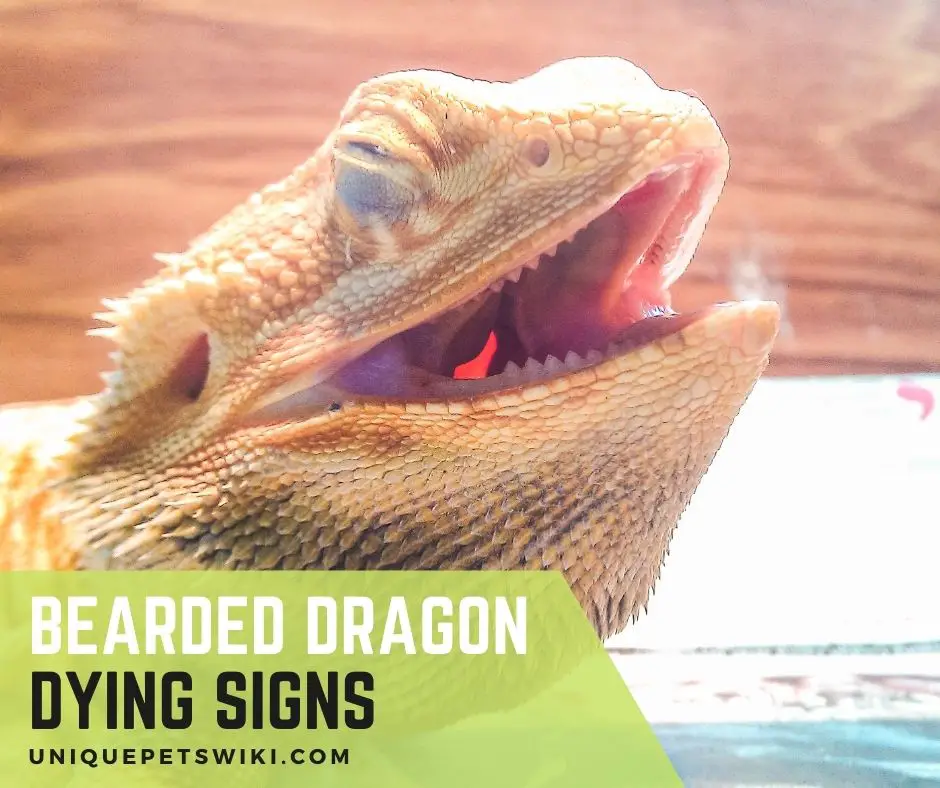How can I tell if my bearded dragon is healthy? What are the signs of a dying bearded dragon? You aren’t the only keeper concerned about the health of your bearded dragon.
Every good keeper is and you’re at the right place to get all your questions answered. Bearded dragons are one of the reptile animals known to be less susceptible to diseases if kept in appropriate conditions.
Because of this, it’s easy to overlook some symptoms or signs that are not well pronounced till it gets worse. Always, what distinguishes a good keeper from a bad one is how well they know their pet and can care for it.
As a caregiver, you must, first of all, understand everything about caring for the species of animal you’re keeping as a pet. Secondly, you must be observant in your care to detect inconsistencies in your animal in time.
Keep in mind that early detection can make a difference between your pet staying alive or dying. To be on top of it, this article will discuss all the sick and dying symptoms of bearded dragons and what you can do to save your pet.
Note that not all symptoms automatically lead to death. Some symptoms are can be remedied by adjusting your husbandry, while serious conditions will require diagnosis and treatment from an experienced vet.
But saving your bearded lizard’s life depends on when you found out it was sick and how fast you take action.
After reading this article, you’ll have a full understanding of your bearded dragon and can also tell between sick symptoms and bearded dragon dying symptoms. Keep reading to the end.
This article has been reviewed by Dr. Dilber. Read more about our knowledge control process here.
Contents
- Bearded Dragon Dying Signs
- How To Tell If Your Bearded Dragon Is Sick?
- 15 Signs Of A Sick Bearded Dragon
- Unresponsiveness to stimulus (lethargic)
- Impaction/Lack Of Stool
- Bloody & Offensive stool And Diarrhea
- Loss Of Appetite And Weight Loss
- Difficulty Walking/Moving
- Skin Infection
- Wrinkly Skin
- Shallow/Faint Or Difficulty Breathing (That Is Breathing With Mouth Open)
- Preferring One End Of The Enclosure, Especially The Cold End
- Discolored Stomach
- Cloudy, Sunken, Or Filmy Eyes
- Can You Treat A Sick Bearded Dragon?
- Ill Symptoms That You Can Treat At Home
- When Do You Need A Vet?
- Symptoms That You Need A Vet
- How To Help Prevent Sickness In Bearded Dragon
- Wrapping Up
Bearded Dragon Dying Signs
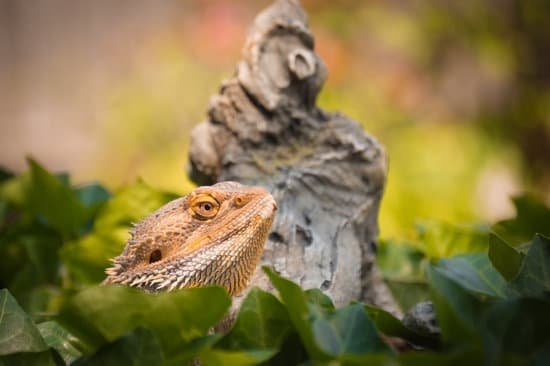
You can tell your bearded dragon is dying if it exhibits the following symptoms:
- Wrinkly, grey, and dull-looking skin.
- Unresponsiveness to stimulus (lethargy) when the lizard isn’t brumating.
- Droopy and sunken eyes.
- Shallow/faint breathing.
- Diarrhea and stool issues.
- Loss of appetite for a long time.
- Stays in the cold end all the time.
- Not moving, trembling, or shaking.
- Wrinkly skin or other dermal issues
- Dehydrated skin and eyes.
Bearded dragons have simple care requirements but most times keepers miss out on one or two things that are essential for their health.
One funny fact about reptile animals is that when kept in homes as pets, any mistake in their husbandry can cause serious health issues that the keeper may not know. It can be a mistake in their diet, cage temperature, or humidity.
Since they are mere lizards without any proper way of communicating their feelings to their keepers, the only way to know if they’re in good conditions or not is to observe their behavior from time to time and keep records of these behaviors.
Behaviors such as eating habits, stools, active levels, skin/eye color, and many others. Most of the time the cause of these diseases that can lead to death is husbandry related which can be fixed.
But if the problem isn’t detected and fixed on time, then your bearded dragon may just be at the point of death. But before it breathes its last, you’ll notice the above signs.
How To Tell If Your Bearded Dragon Is Sick?
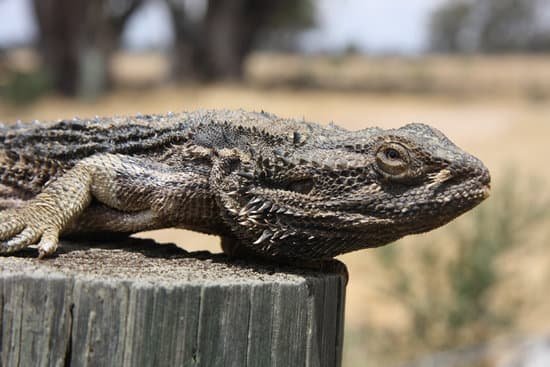
As mentioned earlier, bearded dragons do not have advanced communication skills like dogs. They can’t bark or cry to tell you that they’re hungry, sick, or sad.
Hence, they only communicate by exhibiting behaviors that aren’t consistent with their normal behaviors. Behaviors such as not passing stool, not eating, and inactivity.
Once you’re able to identify these behaviors and know what they mean, then you can be sure to remedy the situation earlier enough before it gets worse.
Thus, it’s all right to say that you can only tell if your bearded dragon is sick if you know what each behavior it exhibits stands for.
That said, this section will discuss some of these abnormal behaviors and what they mean.
15 Signs Of A Sick Bearded Dragon
Talking about sick signs of bearded dragons is to help you take action sooner before it’s too late.
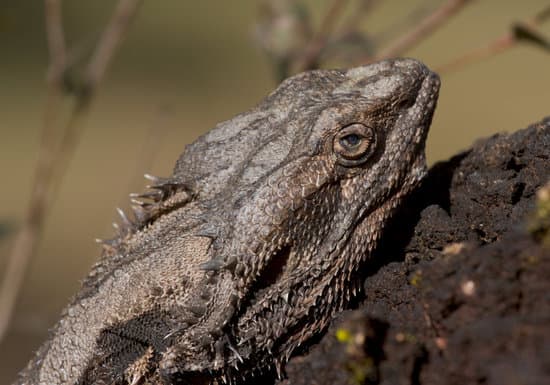
Unresponsiveness to stimulus (lethargic)
Not responding to stimulus can be a sign of good health. This will only happen when the lizard is in brumation. However, if it isn’t brumation season and your bearded dragon is appearing lethargic, then you need to be concerned about its health.
Often what causes lethargy is a sign of some underlying illness and it can also be a drop in the temperature, causing less activity.
If your bearded dragon is appearing lethargic, you, first of all, have to evaluate the heating and lighting lamps in its cage to know if they’re emitting the right amount of heat.
If your heating sources aren’t providing the ideal temperature, correct it as soon as possible. Once temperature is ruled out, you can then suspect a weakness of the bones caused by Metabolic Bone Disease.
Impaction/Lack Of Stool
Lack of stool is often a result of impaction and impaction is caused by dehydration. When your lizard is unable to poop after some days of eating, it means that it has not had enough water in its body to help in digesting the food.
If a bearded dragon is fed with food difficult to digest and the temperature in the enclosure is not proper, impaction will occur. The undigested food becomes compact and it becomes difficult for bearded dragon to expel it out.
This will cause impaction. Hence, if the issue is not detected in time and remedied, it can lead to death. To treat this, you need to offer your lizard plenty of water to drink and also bathe it in warm water.
Bloody & Offensive stool And Diarrhea
On the other hand, instead of no stool, your lizard may be having a running stool or stool containing blood. This can be from the diet especially if you bought its food from the wrong sources.
Bloody poop, runny poop, and diarrhea are the symptoms of intestinal problems. They can be caused by parasitic infections, enteritis, improper diet, ulcers, and bacterial infections. If the microbial infections are not treated in time, they can lead to severe diarrhea.
Intestinal parasites are another reason your lizard will poop blood or have watery poop. Thus, if your bearded dragon has an intestinal parasite, it’ll also poop blood or have watery poops.
This illness is NOT something you should treat yourself at home, You Need To Visit A Vet Immediately.
Loss Of Appetite And Weight Loss
Loss of appetite and weight loss are the two most common and obvious signs that you’ll know your beardy is sick and needs help. Besides sickness, if the temperature in its cage is below normal, it’ll trigger your beardy not to eat.
This is because they are cold-blooded and they need heat to digest their food. Therefore, if your beardy hasn’t eaten and drank for a while it’ll lose weight. A significant weight loss in a short time is often a serious problem.
Difficulty Walking/Moving
This is a sign that often requires medical help. Your pet bearded dragon may have problems moving or walking for two reasons.
Firstly, it can be that your lizard fell off from one of the cage accessories in its enclosure and got itself injured in the leg. Secondly and most likely is that your lizard may be suffering from Metabolic Bone Disease (MBD) caused by calcium deficiency.
To be sure which one it is, an X-ray needs to be done to rule out injury in the leg. If it happens that your lizard fell off a branch and got its leg broken, your vet will know what to do to treat it.
However, if it’s a metabolic bone disease, then you’ll need to supplement your lizard’s diet with calcium and vitamin D3.
Skin Infection
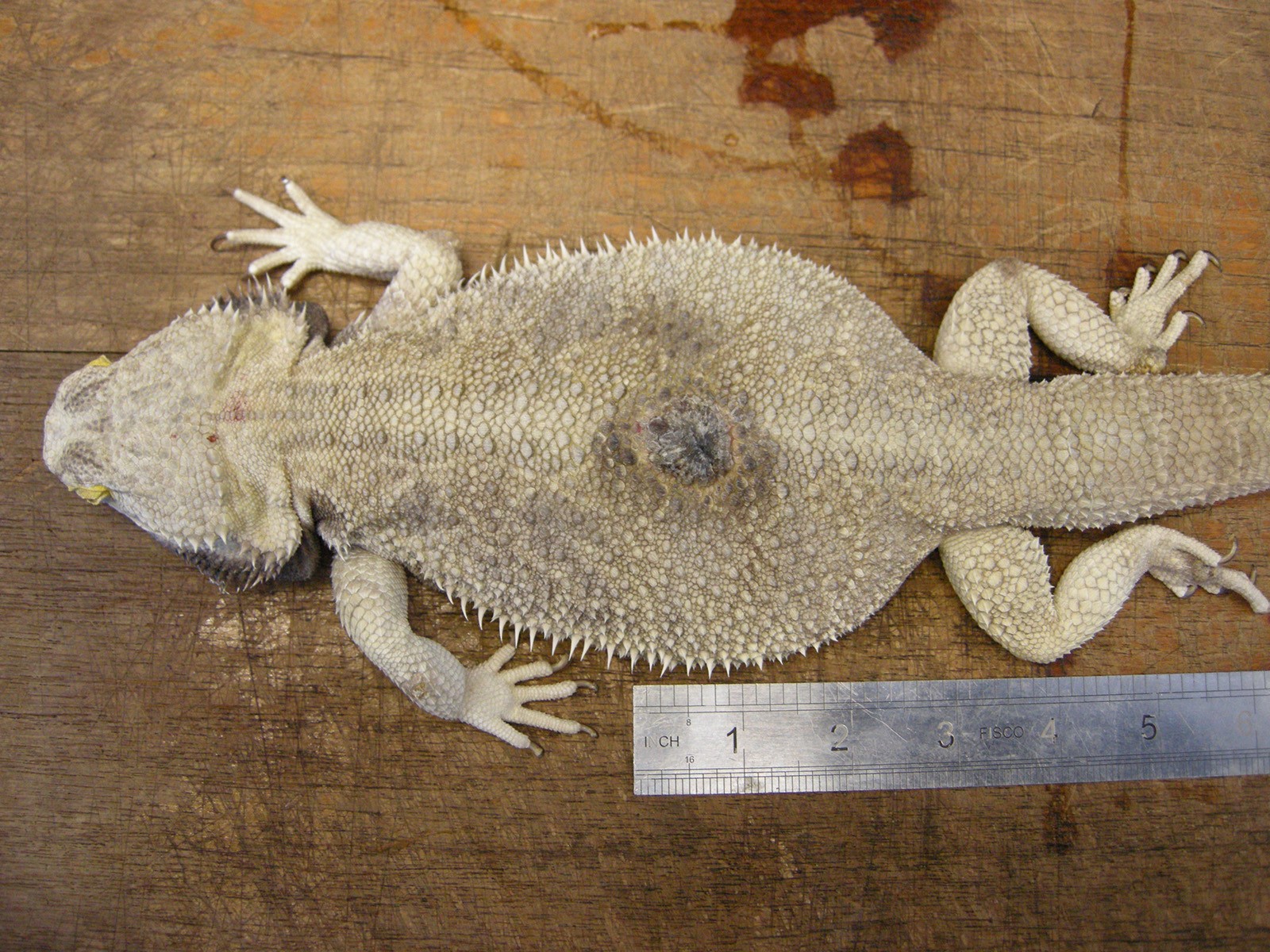
You may notice some inflammation or swelling of the skin, discolored patches especially in the mouth area, and some open wounds in the skin of your lizard. These are all indications that your bearded dragon is suffering from a fungus infection.
Skin infections in bearded dragons occur due to high humidity, low temperature, and suppressed immune systems. As a result, fungus can easily grow and leads to the inflammation of dermal cells.
Once detected, take it to a vet immediately for treatment with antibiotics. However, to prevent this you have to ensure that your lizard’s enclosure is kept clean and dry at all times. High humidity and the wet enclosure is often the cause of skin infection.
Wrinkly Skin
Naturally, bearded dragons have wrinkly skin and some scales. But a healthy skin will look fresh, contain moisture, and show some elasticity when pulled up. What this means is that if you should pull up its skin with your fingers, it should settle back in.
But a dry and wrinkly skin will not settle in. A visibly wrinkly skin will look skinnier and the fatty reserves in the tail will appear sunken in. To test this, try pulling up your lizard’s scales and watch if it settles back.
That said, when you notice wrinkly skin in your lizard, know that it is dehydrated. Hence, what you should do is to offer it plenty of water to stay hydrated.
Shallow/Faint Or Difficulty Breathing (That Is Breathing With Mouth Open)
Any of these signs is a symptom of respiratory infection. Respiratory infections activate the anti-inflammatory response of immune cells. As a result, blood circulation to the respiratory tissues increases to fight against foreign pathogens.
Viruses and bacteria damage the epithelial cells of the respiratory tract and decrease the capability of dragons to exchange air with the environment. So, the dragon feels difficult to inhale and exhale air.
Respiratory infection is often caused by wrong humidity levels. A raised humidity with low temperatures will give viruses and bacteria a good ground to breed and infect your lizard.
Once you notice any of these breathing signs, take your pet to the vet immediately. Respiratory infection if not treated in time can kill the lizard in no time.
Preferring One End Of The Enclosure, Especially The Cold End
Every reptile kept in captivity will have both the warm side and cool side with a basking spot. In each of these areas, certain temperature ranges are to be maintained at all times with slight fluctuations.
Since they’re cold-blooded, they rely entirely on their environment to regulate their body temperature. Hence, once the temperature you provide isn’t within the ideal range, it becomes a problem for them.
That said, if you notice your lizard spending more time in the hot end or basking all the time, know that the temperature is low and your humidity is high which is why your lizard is trying to stay warm and dry.
However, if you notice your lizard always digging a burrow, staying under an accessory that provides shade, or spending more time in the cold end, then it’s an indication that the cage is too hot.
Extreme temperatures (either too cold or too hot) can negatively affect your bearded dragon. While too hot will cause severe skin burns, too cold will cause skin and respiratory infection.
The rule of thumb is maintaining an ideal temperature or 75⁰ – 85⁰ F. Read our article on that.
Discolored Stomach
Stress can cause this, making the stomach of your bearded dragon become black. A discolored stomach is a sign of environment-induced stress in bearded dragons. You need to maintain a proper environment in enclosure and check stress inducing stimuli such as temperature and lighting.
Cloudy, Sunken, Or Filmy Eyes
A healthy bearded dragon will have clear and bright-looking eyes. Anything other than this tells you that your lizard is sick. In severe cases, where a discharge is coming out from the eyes, it could be an infection. Any problem with the eyes needs the attention of a vet.
In all, you may ask, so at what point will my bearded dragon get sick and die? Remember when I mentioned that all these signs do not mean that your lizard will die. Your Lizard Will Only Die If Any Of These Signs Was Not Detected And Remedied On Time.
Bearded dragons like other reptiles are sensitive to their husbandry, especially temperature. What this means is that a slight negligence on your part as a keeper can cause serious health issues to the lizard.
That notwithstanding, the illness can be remedied. But if you didn’t notice it in time, then the lizard can die. This is why close examination and keeping of records of everything about your lizard cannot be overstated.
Can You Treat A Sick Bearded Dragon?
Bearded dragon sickness somehow can be treated at home, depending on what disease/illness your bearded dragon is sick of and how severe it is.
Impaction
Illnesses such as impaction can be treated by providing your lizard lots of fresh water to drink and bathing it in warm water to help loosen stool.
Impaction can also be treated with medications such as digesters. As impaction can also be caused by undigested food in the intestine, the medicated digester helps to digest this food and expel it from the digestive tract.
Loss Of Appetite And Lethargy
Loss of appetite and lethargy when it isn’t a brumation period can be the result of wrong cage temperature. Hence, to treat or prevent these, you must ensure that the ideal temperature range is maintained in your lizard’s enclosure at all times.
Ideally, it’s recommended that you have a thermometer in its cage to keep check of the temperature.
Metabolic Bone Disease (MBD)
Often, poor dieting and low absorption of calcium do cause an illness called Metabolic Bone Disease (MBD). Thus, even when your UVB bulbs are working fine and you’re offering varieties in its diet, supplementing their diet with calcium and vitamin D3 supplements is important.
Respiratory And Skin Infection
Wrong humidity with low temperatures is the common cause of respiratory and skin infections. If the humidity is high, causing the substrates and the entire cage to be wet, your bearded dragon is likely be infected with a respiratory tract and skin infection.
To treat your bearded dragon of these diseases you’ll need to apply some antibiotics to the skin or give it orally. But note that the antibiotics must be recommended by a certified vet.
Nice video: My friends in Vietnam successful treated a bearded dragon.
Notes: In some countries, there are NO vets for reptiles, and they (owners) need to do a lot of research and also treat themselves. We don’t recommend any one of our readers treat their sick bearded dragons AT HOME.
But in some cases, if you can’t visit a VET, research and take action sooner.
Ill Symptoms That You Can Treat At Home
From what have been discussed earlier, the ill symptoms that you can treat at home include:
- Impaction or no stool.
- Skin infection.
- Sunken or droopy eyes. You treat this by hydrating your lizard.
- Early-stage of Metabolic Bone Disease (MBD). Ensure you supplement its diet with calcium and vitamin D3.
- Wrinkled skin. Can be treated by offering lots of water.
- Lethargy or inactiveness. Evaluate your temperature and raise it to normal.
- Loss of appetite and weight loss. Evaluate your husbandry to know why.
When Do You Need A Vet?

To save the life of your pet bearded dragon, below are when you need to see a vet:
- When your lizard shows some signs and symptoms that aren’t among the signs that you can treat by yourself at home, then you need to take it to a vet.
- Moreover, you’ll need to see a vet if your bearded dragon exhibits some behaviors that you don’t understand. Proper medical examination and diagnosis will tell what is wrong and what to do to remedy it.
- You’ll also need to see a vet if you’re confused. If you aren’t sure of what illness your bearded dragon is sick of, it is better you take it to a vet than try to administer treatment yourself based on assumption.
Improper diagnosis and treatment are as dangerous and deadly as the illness itself. To this end, do not rely on family and friends for advice on what to do to your pet lizard when it is ill. Unless they’re experienced in it.
Symptoms That You Need A Vet
Some of the symptoms discussed earlier are what you can see a vet for to properly diagnose and administer treatment. Other than that, if you notice these severe symptoms in your pet bearded dragon, rush it to the vet almost immediately. The symptoms include:
- Diarrhea.
- Bloody stool.
- Respiratory infection.
- Impaction that has prevented stool-passing for up to a month or more. Especially if you’ve had failed attempts treating it yourself at home.
- Unresponsiveness to stimulus (lethargy) even when the temperature has been raised for some time.
- Have difficulty walking or moving. That is, walking and dragging itself along. It can deform bones or weak limbs.
- Mouth and tail rot.
- Loss of appetite and weight loss that you can’t explain.
How To Help Prevent Sickness In Bearded Dragon
The bottom line of prevention is good husbandry. All diseases and illnesses related to captive bearded dragons are husbandry-related. That said, to prevent all these illnesses, you must adhere to the following tips:
- Proper Nutrition: Offer varieties of foods to your beardy and ensure that you buy these foods from trusted sources.
- Always maintain good hygiene. Wash your hands before and after handling your pet.
- Have a regular clean-up routine to ensure that your lizard’s enclosure is kept clean at all times.
- Maintain an appropriate temperature and humidity level in the cage. Have a thermometer to measure and keep records.
- Weigh and record the weight of your bearded dragon at least once a week.
- Check periodically to ensure that your heating, lighting, and UVB bulbs are functioning properly.
- Handle your pet from time to time. Occasionally take your beardies out of the cage and bond with it. With this, it’s easy to notice if something is wrong.
- Avoid stress in your lizard’s habitat. Eradicate everything that can cause bearded dragon stresses.
Wrapping Up
It’s a painful sight to watch your cherished pet die of a sickness that could have been treated if you had found out in time. This is why we designed this article to help you figure out in time what could be wrong with your pet bearded dragon and what to do.
Always keep in mind that these illnesses are a result of poor husbandry. Moreover, even if your beardy gets sick, it can still be treated if you find out in time. The reason why illnesses often lead to death are late detection and treatment and wrong diagnosis.
After reading this article, we believe that you’ll not lose your beardy to death because you’ll know what to do.
